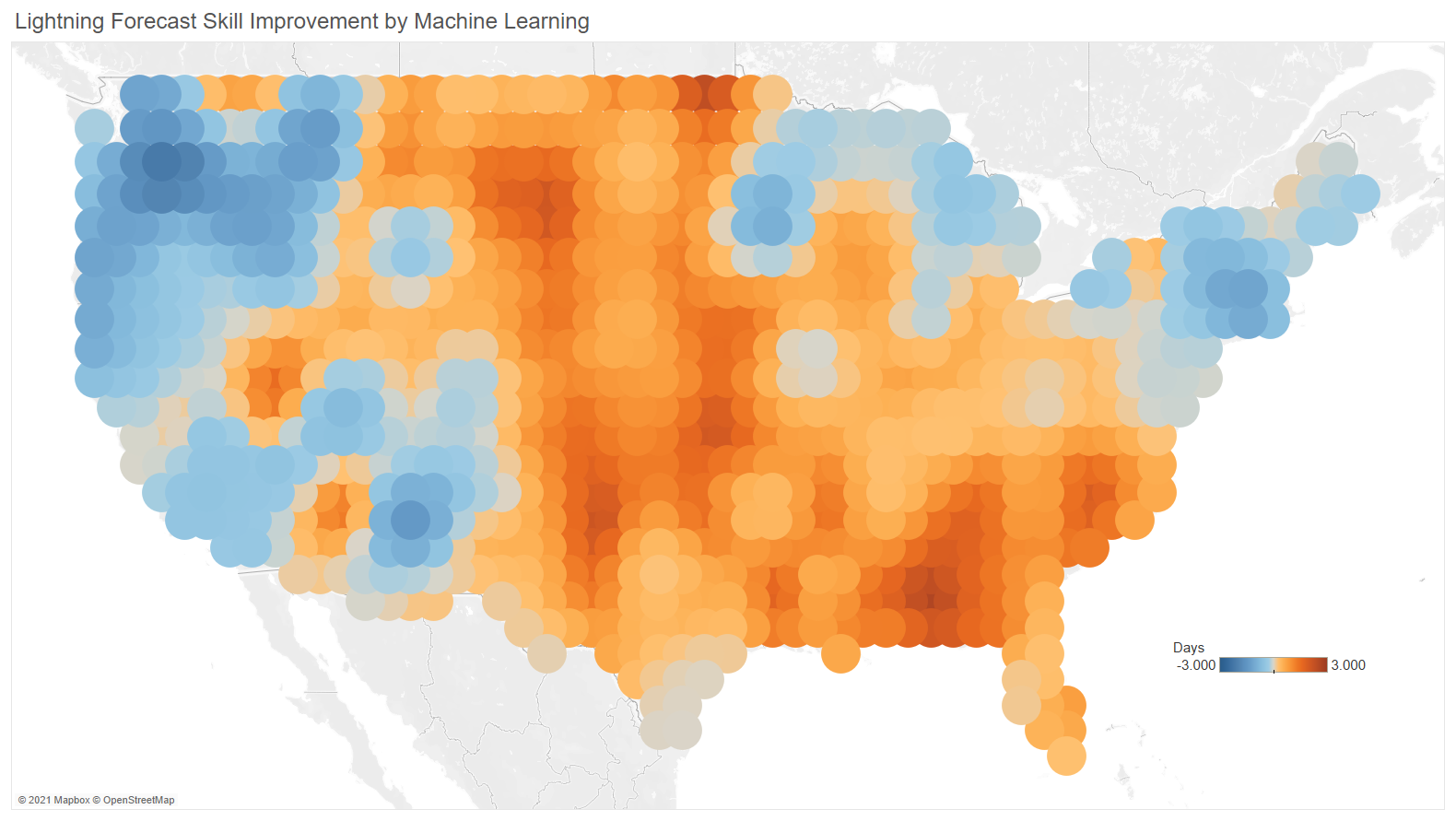Lightning happens to be one of the most devastating forces of nature. In 2020, it triggered the huge California Lightning Complex fires; however, it still is a challenge to predict.
 A comparison of the performance of the new, AI-supported method and the existing method for U.S. lightning forecasts. The AI-supported method was able to accurately forecast lightning on average two days earlier in places like the Southeast, where lightning is common. Because the method was trained on the entire U.S., it did less well in places where lightning is less common. (Image Credit: Daehyun Kim/University of Washington. Map by Rebecca Gourley/University of Washington).
A comparison of the performance of the new, AI-supported method and the existing method for U.S. lightning forecasts. The AI-supported method was able to accurately forecast lightning on average two days earlier in places like the Southeast, where lightning is common. Because the method was trained on the entire U.S., it did less well in places where lightning is less common. (Image Credit: Daehyun Kim/University of Washington. Map by Rebecca Gourley/University of Washington).
A new study guided by the University of Washington demonstrates that machine learning — computer algorithms that better themselves without direct manual programming — can be used to enhance lightning forecasts.
Improved lightning forecasts could help prepare for possible wildfires, enhance safety warnings for lightning and develop more precise long-range climate models.
The best subjects for machine learning are things that we don’t fully understand. And what is something in the atmospheric sciences field that remains poorly understood? Lightning. To our knowledge, our work is the first to demonstrate that machine learning algorithms can work for lightning.
Daehyun Kim, Associate Professor of Atmospheric Sciences, University of Washington
The new method integrates weather forecasts with a machine learning equation based on studies of former lightning events. Showcased at the December 13th American Geophysical Union’s fall meeting, the hybrid technique can forecast lightning spanning the southeastern United States two days earlier than the popular existing method.
“This demonstrates that forecasts of severe weather systems, such as thunderstorms, can be improved by using methods based on machine learning,” said Wei-Yi Cheng, who did the work for his UW doctorate in atmospheric sciences. “It encourages the exploration of machine learning methods for other types of severe weather forecasts, such as tornadoes or hailstorms.”
Scientists fed the system with lightning data from 2010 to 2016, allowing the computer to ascertain relationships between lightning strokes and weather variables. Then, they examined the method on weather conditions from 2017 to 2019, comparing the AI-supported method and a current physics-based method, using real-world lightning observations to assess both.
The new technique could forecast lightning with the same skill approximately two days earlier than the leading method in areas, like the southeastern United States, that tend to face a lot of lightning. Since the technique was trained on the whole United States, its performance was not as exact for areas where lightning is rare.
The technique used for comparison was a newly formulated process to predict lightning based on the precipitation quantity and the ascent speed of storm clouds. That technique has estimated more lightning with climate change and a constant increase in lightning over the Arctic.
The existing method just multiplies two variables. That comes from a human’s idea, it’s simple. But it’s not necessarily the best way to use these two variables to predict lightning.
Daehyun Kim, Associate Professor of Atmospheric Sciences, University of Washington
The machine learning was fed with lightning observations from the World Wide Lightning Location Network, a collaborative based at the University of Washington that has monitored global lightning since 2008.
Machine learning requires a lot of data—that’s one of the necessary conditions for a machine learning algorithm to do some valuable things. Five years ago, this would not have been possible because we did not have enough data, even from WWLLN.
Daehyun Kim, Associate Professor of Atmospheric Sciences, University of Washington
Commercial networks of tools to track lightning currently exist in the United States, and newer geostationary satellites can track a single area nonstop from space, supplying the exact lightning data to render more machine learning possible.
“The key factors are the amount and the quality of the data, which are exactly what WWLLN can provide us,” Cheng said. “As machine learning techniques advance, having an accurate and reliable lightning observation dataset will be increasingly important.”
The scientists are keen to enhance their technique using more data sources, more weather variables and more advanced systems. They would like to better predict specific situations such as dry lightning, or lightning without rainfall, as these are particularly hazardous for wildfires.
Scientists believe their technique could also be utilized for longer-range projections. Longer-range trends are relatively significant because lightning impacts air chemistry, therefore forecasting lightning results in better climate models.
In atmospheric sciences, as in other sciences, some people are still skeptical about the use of machine learning algorithms—because as scientists, we don’t trust something we don’t understand. I was one of the skeptics, but after seeing the results in this and other studies, I am convinced.
Daehyun Kim, Associate Professor of Atmospheric Sciences, University of Washington
The study’s other collaborators include Scott Henderson and Robert Holzworth at the University of Washington, and Yoo-Geun Ham and Jeong-Hwan Kim at Chonnam National University in South Korea.
Source: https://www.washington.edu